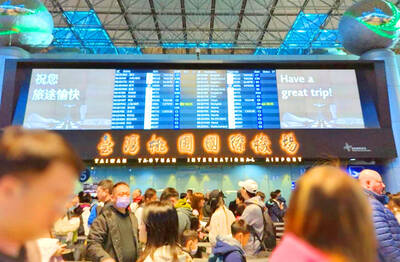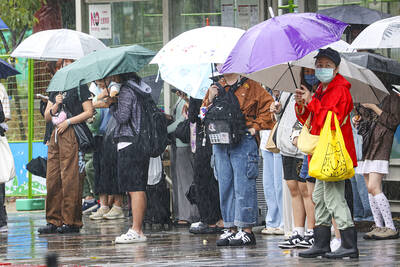From the old steam-powered locomotives that went into service near the end of the Qing Dynasty to the blue-and-white Chukuang Express trains seen in Taiwan in the 1970s, the nation’s first original railway historical comic, created by 34-year-old cartoonist Chien Chia-cheng (簡嘉誠), whisks readers down memory lane, reminiscing over many of Taiwan’s trains.
Chien’s two-year brainchild, Time Travel: A Journey to Collect Train Tickets (時空鐵道之旅), transports readers back 100 years with the two main characters, former high-school acquaintances.
It all starts with a railway accident the two characters get into after bumping into each other on a Tzuchiang Express train, which sees them accidentally falling into a time tunnel to the past.

Photo courtesy of Gaea Books Co
In order to make their way back to the present, the pair must jointly accumulate tickets for train models of the past, ranging from the country’s oldest steam locomotives and the Taiwan Sugar Railway trains, to the red-painted Alishan Forest Railway trains and the legendary blue-and-white Chukuang Express trains.
Taiwan’s first railway line, which linked Keelung to Taipei, was completed in 1891, when the country’s first two steam locomotives, named Teng-yun (騰雲) and Yu-feng (御風), were imported from Germany and went into service.
Many saw the steam-powered locomotives as giant smoky monsters, and passengers who forgot to close the window risked having their faces turned black by the thick smoke coming from the steam engines.
In 1902, the Taiwan Sugar Railway trains were introduced for transporting sugarcane in central and southern Taiwan, becoming one of the country’s major transportation systems because of the limited passenger service they offered.
The sugar railway lines also passed through the Chiayi-based Tung Shih Agricultural School — the predecessor of National Tung Shih Senior High School.
In 1912, the Alishan Forest Railway trains came into operation under the Japanese colonial government to facilitate shipping of valuable wood logged in the area, with most of them now serving as tourist trains.
Aside from a variety of trains, appealing uniformed attendants who used to peddle meal boxes and help passengers send telegrams or registered letters are also featured in the comic book.
The so-called “Miss Chukuang” (莒光號小姐) were so well-liked at the time that some of them even received wedding proposals and diamond rings from passengers while on duty.
Chien’s book has been highly acclaimed by readers and made it onto a best seller list shortly after its launch on Oct. 31.
Railway expert Su Jiao-shi (蘇昭旭), who has written about 30 railway-themed publications, also wrote a prologue for Chien’s comic creation.
“I am deeply touched by the book … which is no less a work than the many Chinese translations of Japanese railway comics that have long dominated the Taiwanese market,” Su said in the prologue.
“This is not only the first original comic book about Taiwan’s national railway history, but also an example of the delicate transformation of written histories into vivid images,” Su said.
Chien said he only decided to create the book after accumulating relevant background information for a railway-themed short comic piece for the best-selling magazine Creative Comic Collection.
“Knowing that there used to be trains traveling through a campus just got me interested and spurred me into creating a series of stories that centered on locomotives,” Chien said.
Since Chien’s storyline covers a 100-year history of railway transformation, conducting research on the designs of various trains and the cultural backgrounds of different eras — such as the distinctive features of costumes and the currencies in use at the time — was the most arduous part of the creative process.
“Historical research was rather painstaking. While there is plenty of information and photographs, I still couldn’t get the whole picture and could only try to fill in the blanks myself,” Chien said.
When asked about what kind of reaction he expects from readers, Chien said: “As long as people get the feeling of wanting to ride on one of those trains in my book, it’s good enough for me.”

Foreign travelers entering Taiwan on a short layover via Taiwan Taoyuan International Airport are receiving NT$600 gift vouchers from yesterday, the Tourism Administration said, adding that it hopes the incentive would boost tourism consumption at the airport. The program, which allows travelers holding non-Taiwan passports who enter the country during a layover of up to 24 hours to claim a voucher, aims to promote attractions at the airport, the agency said in a statement on Friday. To participate, travelers must sign up on the campaign Web site, the agency said. They can then present their passport and boarding pass for their connecting international

Temperatures in northern Taiwan are forecast to reach as high as 30°C today, as an ongoing northeasterly seasonal wind system weakens, the Central Weather Administration (CWA) said. CWA forecaster Tseng Chao-cheng (曾昭誠) said yesterday that with the seasonal wind system weakening, warmer easterly winds would boost the temperature today. Daytime temperatures in northern Taiwan and Yilan County are expected to range from 28°C to 30°C today, up about 3°C from yesterday, Tseng said. According to the CWA, temperature highs in central and southern Taiwan could stay stable. However, the weather is expected to turn cooler starting tonight as the northeasterly wind system strengthens again

COOLING OFF: Temperatures are expected to fall to lows of about 20°C on Sunday and possibly 18°C to 19°C next week, following a wave of northeasterly winds on Friday The Central Weather Administration (CWA) on Sunday forecast more rain and cooler temperatures for northern Taiwan this week, with the mercury dropping to lows of 18°C, as another wave of northeasterly winds sweeps across the country. The current northeasterly winds would continue to affect Taiwan through today, with precipitation peaking today, bringing increased rainfall to windward areas, CWA forecaster Liu Pei-teng (劉沛滕) said. The weather system would weaken slightly tomorrow before another, stronger wave arrives on Friday, lasting into next week, Liu said. From yesterday to today, northern Taiwan can expect cool, wet weather, with lows of 22°C to 23°C in most areas,

Taiwan sweltered through its hottest October on record, the Central Weather Administration (CWA) said yesterday, the latest in a string of global temperature records. The main island endured its highest average temperature since 1950, CWA forecaster Liu Pei-teng said. Temperatures the world over have soared in recent years as human-induced climate change contributes to ever more erratic weather patterns. Taiwan’s average temperature was 27.381°C as of Thursday, Liu said. Liu said the average could slip 0.1°C by the end of yesterday, but it would still be higher than the previous record of 27.009°C in 2016. "The temperature only started lowering around Oct. 18 or 19